 |
| Bereitschaft = Readiness (1939) Arno Breker (German, 1900-1991) Bronze Kunstmuseum Nörvenich; Museum Arno Breker, Sammlung Europäische Kunst |
Monday, December 28, 2020
Bereitschaft by Arno Breker
Saturday, December 12, 2020
The Vanishing Sky by L. Annette Binder
 |
| London : New York : Bloomsbury, 2020 |
Etta is determined to get her husband and both of her sons through the war at all costs—it is her sole focus. Her older son, Max, has just returned from the war and she recognizes that something isn't right with him, something that we would now recognize as post-traumatic stress disorder. While Max spends his days unsuccessfully running from the battlefield horrors that have imprinted on his mind, Joseph, his father, seems only encouraged by the dubious news stories of Germany's success. While struggling with signs of dementia, he still has a certain nostalgia for his own years fighting in the first world war and is determined to fight in this war now that the old and the young are being called upon to serve.
Georg, an overweight bookish boy, is nearly 200 miles away at a Hitler Youth school. He is trying to hold on and avoid the inevitable day when he reaches the age of sixteen and will be sent to fight. He sees what happens to those who flee. While there he discovers he has feelings for one of the other boys, Müller. They become close friends but Georg knows that the reality of their relationship must be kept secret.
An excellent writer can create psychological atmosphere—a way of projecting an emotion or feeling onto the reader related to the events of the novel and the internal dialogue and emotional state of the characters themselves. Binder's strength in this regard is her ability to convey the overwhelming sense of dread and the sense of inevitability among the characters in a small village in Germany near the end of World War II. That dread doesn't simply come from the reader's knowledge of how a novel set in this time and place is going to end. It comes from reading the lived experience and the inner dialogue of the characters that the author has created. It is compelling and creates a natural empathy for their plight.
Binder's Hitler Youth School and the Schools of Classic Boarding School Novels : Some Parallels
One would not normally think a novel such as this would have any relationship to classic English boarding school novels of the early twentieth century, but the parallels couldn't be more clear. The culture and activities at the Hitler Youth school are not so different than those of the schools in classic English boarding school novels of the time. There is a general veneration of those students who came before and went off to war, a focus on physical prowess—in this case in war games instead of cricket, and the classic close friendship.
The focus of the Hitler Youth school was not one of academics. One might not call it a school at all given that it served primarily as a military training camp for teens. The school in a traditional English boarding school novel would teach students Latin, Greek, math, etc.—subjects that Georg shows an unusual interest in. In an English boarding school, those who went to war were venerated because of the selfless act of choosing to go to war. The teens at the Hitler Youth school had little choice about attending the school and upon reaching the age of sixteen would be required to join the military ranks.
The traditional English boarding school activities such cricket competitions have been transformed in the Hitler Youth school to weapons competitions, physical training, digging trenches and building defensive walls—basic skills needed to function in a world of war.
Maybe the most important aspect of the classic boarding school novel is the overly close relationship between two of the boys. It is suggested that Georg's closeness with Müller is not invisible to the other boys, but they know that it needs to remain hidden from the adults. The love between these two characters is presented in a similar way as the great loves of boarding school novels, really quite chaste in character, but certainly real in their own hearts.
Binder has done an amazing job of merging genres by mixing elements of the classic boarding school novel with an historical fiction that turns what we think of as a World War II story on its head.
Monday, November 23, 2020
Tuesday, November 10, 2020
The Mail Boat by Alexander Randolph
 |
| London : Heinemann, 1954 |
Told through a series of twenty-four letters, The Mail Boat is the story of Martha Baker and Oscar Tower's meeting in Rome at a bar catering to artistic people (read gay) on the Via Babuino, their relationship, and their subsequent time together on a tiny Tyrrhenian island where Oscar plans to work on his next novel. The mail boat that stops twice a week at the island anchors the activities of daily life.
Oscar corresponds with his friend Andrew (André) MaCloy, initially in Paris and later in Venice. Martha writes to her mother, Olga Baker and Janet Picard, a friend in New York, as well as Thomas Purdon, a former love interest and a professor at Yale. The recipient of the letter seems to determine the level of candor about the happenings on the island and Martha and Oscar's relationship.
Martha is deeply in love with Oscar and certainly has plans for their future. Oscar is much cooler and more casual about the relationship. He enjoys spending time with Martha but tends to ignore Martha when she suggests a more committed situation. Oscar is also distracted by a 13-year-old boy named Mario, the most beautiful of the local boys, with whom he would much rather spend his time. Martha is incensed at being ignored in favor of this street kid but also knows Oscar isn't really that way because he isn't effeminate at all. While Oscar won't admit it, even to himself, Martha is very clear in her understanding of Oscar's relationship with Mario, even going as far as telling Thomas in her letter that if Oscar would "just do something with the boy...it would be over in no time at all." (p.87)
Oscar's nature, although seemingly invisible to himself, is made clear by the author when friends visit from America, a literary agent and his 'esthetic' boy friend who plays tennis. In Martha's letter describing the visit and the dinner, she says, "They argued about a French poet who sounds like rainbow," (p.76) clearly a reference to Rimbaud. Later in passing, she also mentions that Oscar was wearing a black turtleneck sweater, which belonged to Martha.
Randolph is a bit coy in describing the island as Tyrrhenian. About half way through the book, when Martha is describing the day she and Oscar went to see the lighthouse, the description, while not a perfect match, comes very close to describing the Punta Carena Lighthouse on Capri. Given the long history of gay artists and authors on Capri and their relationships with the teenage locals, it seems fitting that Randolph would suggest this location.
Bibliographies & Ratings: Cory (IV); Garde (OTP, c**); Mattachine Review (IV); Young (3197)
Friday, October 23, 2020
Deux Hommes dans une Chambre by Bernard Buffet
Thursday, October 8, 2020
Giovanni's Room by James Baldwin
 |
| New York : The Dial Press, 1956 |
Giovanni's Room is, at its heart, a psychological novel whose focus is an analysis of masculinity through the lives of its characters. We are first introduced to our narrator, David, a young blond man from Brooklyn who is now living in Paris. By providing the story of his childhood—a mother who dies while David is young, a womanizing father, and an early gay experience after which David effectively ends the friendship—Baldwin sets up the psychological parameters within which David attempts to live.
Now living in Paris, David's girlfriend Hella has taken some time away from the relationship traveling through Spain. Being short on funds, David reaches out to Jacques, an older gay man who can surely afford to help David out. When they go to a gay bar owned by Guillaume, David's inner dialogue about those in the bar says a lot about how he relates to gayness and his own inner struggle with his masculinity and sexuality. There are the older men who take younger men under their wing, young men who are selling their wares, and those who dress and act in a more feminine manner. David struggles in his own mind to understand why a man who is interested in other men would be interested in an effeminate one. It becomes obvious that Jacques has become very interested in the new bartender, Giovanni. As the night progresses, however, it is clear that Giovanni, on the other hand, is interested in David. David's internal dialogue continues, wondering what it says about his own masculinity that Giovanni is so masculine. Nonetheless, that night, David begins living in Giovanni's Room.
As Hella's return to Paris grows closer, David does nothing to prepare Giovanni for what David sees as the end of their relationship. With Hella's return, David abandons Giovanni without a word, kicking off a cascade of events that will affect nearly everyone.
In his 2019 New York Times article, 'Giovanni's Room' Revisited, Hilton Als discusses the initial rejection of Giovanni's Room by the publisher Knopf. "In his letter, the esteemed editor Henry Carlisle ... said the company was turning down 'Giovanni’s Room' not because it lacked fine writing, but because it had so few credible characters and would do nothing to serve Baldwin’s reputation. And that the book’s failure had nothing to do with its subject matter."
Carlisle's inability to see the characters as credible says a lot about the lack of understanding of gay life in America. In addition, gay life in Europe, especially in a major city like Paris was quite different than anything in the U.S. and this is really in many ways at the center of the problems between David and Giovanni. In post-war Paris, homosexuality wasn't illegal, although it would have been considered a moral problem. The openness of the sexuality and the normalization of the various ways gay men got by financially would have been seen as very foreign, a bit vulgar, and maybe not believable from a U.S. editor's perspective. That's the beauty of what Baldwin's experience living in France brought to this story.
Bibliographies & Ratings: Cory (IV); Garde (P, 141***); Mattachine Review (IV); Young (158*)
Wednesday, September 23, 2020
Wednesday, September 9, 2020
Brideshead Revisited by Evelyn Waugh
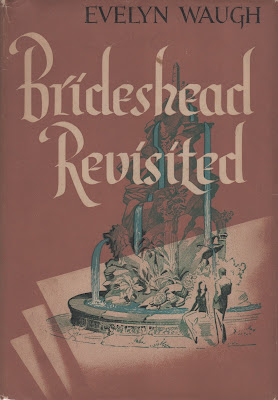 |
| Boston : Little, Brown and Company, 1945 |
Charles meets Sebastian Flyte while at university and begins to spend more time with him and his small group of friends including Anthony Blanche, a flamboyant and open gay man who may be either Spanish or Italian, as this is not completely clear in the text. As many of the circle of friends move away, Charles and Sebastian become even more inseparable. It's clear that Charles has strong feelings for him and is honest with himself about them.
Sebastian invites Charles to spend time with him at Brideshead but seems intent on keeping his family distant, planning visits when he knows family will be away. Sebastian seems to be most himself away from his family who have opinions about what he should do and how he should live. When Charles does finally meet Sebastian's family, the magic in their relationship begins to disappear and the relationship with Sebastian becomes contentious. Sebastian's fears are realized when Charles works with Sebastian's mother to control his behavior.
 |
| Brian Christian de Claiborne Howard John Banting (British, 1902-1971) |
Brideshead Revisited is a classic of gay literature and this is most likely tied to the character of Anthony Blanche. Evelyn Waugh attended university with Brian Howard and it is said that Anthony Blanche is largely based on him. Howard was said to be brilliant and funny but in the end didn't accomplish much in his short literary career. Like Blanche, Howard was openly gay and made no secret about his life. There is a nice write up of Brian Howard's life including his appearance as Anthony Blanche in Brideshead at The Esoteric Curiosa.
Throughout the novel there are themes of love, family, religion (Catholicism) and duty. The Flyte family is so encompassing that any individual relationship is controlled by the family itself. This is why Sebastian feared introducing Charles to the family because 'they would win him over to their side.' While some members of the Flyte family are more devout than others, in the end the Catholicism of the family wins out in nearly every decision and interaction. One can't truly escape one's family and religion. Even Charles who holds strong anti-religious feelings and often has arguments with members of the Flyte family, in the end learns something and is changed by the family's religious devotion.
Thursday, August 27, 2020
Monday, August 17, 2020
Rushing Nowhere by Tom Chetwynd
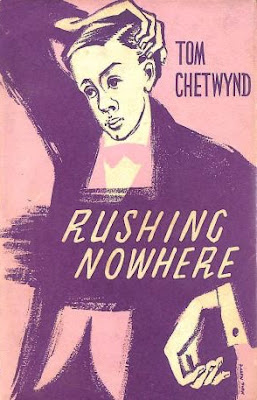 |
| London : Anthony Blond, 1958 |
While in prep school, Guy befriends Fotheringay, a boy who struggles with the typical boarding school issues. After Guy is warned off of a regular interaction he has been having with one of the housemasters, he suddenly tells Fotheringay that they shouldn't hang out all of the time. There is a suggestion that these relationships might turn into something that is too close or inappropriate. Fotheringay is crushed by the hurtful way that Guy cuts things off and shortly afterward he is found drowned in a bathtub. Guy struggles from this point forward, not knowing wether the death was an accident or if their final words to one another led to the boy's death.
This critical moment seems to have had a major affect on Guy's life. While he seeks out relationships with women and other boys (and at one point befriends an older gay man), he consistently stops short when it's clear that everyone has their own agenda. He can't find the organic closeness he had with Fotheringay with any of these people. This inability to connect with others also manifests itself in his inability to stick with any plan for a career or work. His adventures in trying to find himself traveling through Europe come to a close with his being called up by the army, a trap from which he won't be able to escape.
Bibliographies & Ratings: Cory (III); Garde (OTP, b*); Young (651)
Friday, August 7, 2020
Constructed Head of a Man in Profile by Albrecht Dürer
 |
| Constructed Head of a Man in Profile (c. 1512-1513) Albrecht Dürer (German, 1471-1528) Pen, brown ink and dark brown wash on paper 9 9/16 x 7 7/16 in. The Morgan Library and Museum |
Tuesday, July 28, 2020
The World Next Door by Fritz Peters
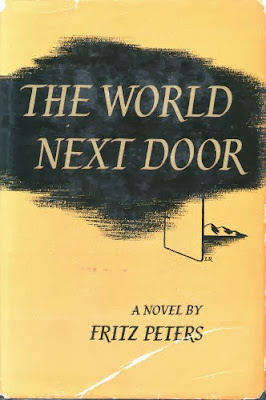 |
| New York ; Farrar Straus, 1949 |
When he arrives, David doesn't know where he is and vacillates between believing he is an American spy being protected by the British and being a prisoner of war being held by the Nazis. It's possible both are true and he can't understand why he isn't being protected from the Nazis.
It's 1947 and it soon becomes clear to the reader, that David has been taken to a psychiatric ward. He doesn't understand why he's there and his agitation and inability to do as he is told lands him in the pack unit, where patients are wrapped tightly in wet sheets, a 'sheet pack', in an effort to calm them down.
Upon his arrival to the unit, he believes, no, he knows that he is Jesus Christ. He has the cigarette-burn stigmata to prove it. What he wants more than anything is for someone—anyone to believe him and to believe in him. When one of the night attendants attempts to rape him, he creates an unbelievable scene and manages to get the priest and the doctor to come to the ward. There he makes a convincing argument for a psychiatric patient's rights. Of course the doctors are going to believe the attendants—the patient is obviously crazy. What kind of power does that put into the hands of the staff? He lives in constant fear of saying the wrong thing. Will it make them angry with him? Will he be punished? There is a powerlessness that is all encompassing. Even as his mind begins to clear, David doesn't trust his own thoughts. David describes being in love with attendants, doctors or other patients who are nice him. He later realizes that it isn't love that he feels, but a sense of gratitude for the gentle way they treat him.
Mr. Newton suggests that David's accusation against the attendant might stem from his own homosexuality. There was also a similar claim in David's file from the army where a general "tried to get funny". David is clear that he had slept with another man in his 20s but is not a homosexual. "I was in love with him, that's all." David's mother had shared with Mr. Newton these earlier experiences "as a possible cause of [his] illness." What's truly at the heart of his illness is a spiritual and moral collapse brought on by an inability to reconcile his spiritual beliefs with the horrors he witnessed during World War II.
The World Next Door is a fictionalized version of the author's own experiences and shows the horrors of psychiatric treatment during the 1940s and 1950s, including the use of wet sheet packs, insulin shock and electro-shock therapies. It was very well received upon publication and shown a bright light on psychiatric hospitals and psychiatric practice broadly, and issues within Veteran's Administration hospitals in particular. Mary Jane Ward, the author of The Snake Pit (1946) wrote the single critical review for The New York Times. She called it 'sincere' and then proceeded to pick it apart. One wonders if this isn't a case of feeling like another author was muscling in on her turf. The book had a significant enough impact that you still find it in medical libraries across America, unusual for a novel. The World Next Door was excerpted in Harper's Bazaar, released in several English editions, translated into both French and German, and was performed in France as a radio play.
Bibliographies & Ratings: Cory (III); Garde (OTP, a***); Mattachine Review (III); Young (3021)
Friday, July 17, 2020
Wednesday, July 8, 2020
The Man in the Red Coat by Julian Barnes
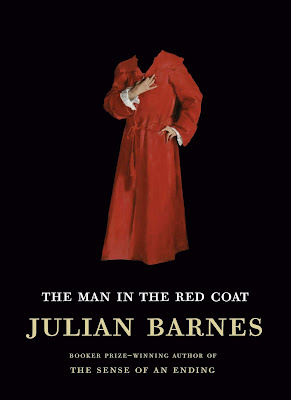 |
| New York : Alfred A. Knopf, 2020 |
The jumping off point is a 1885 trip to London by three Frenchmen for what they termed 'intellectual shopping' (something a dandy would do). One of the members of this trio was Dr. Pozzi. The others were Prince Edmond de Polignac and Count Robert de Montesquiou-Fezensac. So then the question becomes how did this commoner with the Italian name come to make this trip with a prince and a count.
The society during la Belle Epoque in Paris, serves as the foundation of the story Barnes has to tell. The relationships, petty jealousies, duels, and court cases are all included. A cast of characters include many lesser-known individuals, but some major names play a role in the world that the doctor, the prince and count inhabit.
Major literary figures such as Oscar Wilde and Joris-Karl Huysmans (author of A Rebours) appear, along with a fascinating discussion of aestheticism and dandyism. Wilde's trials are discussed in the context of the French vs British court systems. French cases like the Black Masses Scandal involving Baron Fersen (Jacques d'Adelsward-Fersen) who was charged with inciting minors to commit debauchery is briefly noted. A polarizing political issue during this time was the Dreyfus Affair, a blatant example of the anti-Semitism of the time. It's definitely a Who's Who of artists (Sargent, obviously), actresses (Sarah Bernhardt), authors, and society figures of the time period.
In the context of all of this literary and political intrigue was extraordinary progress in medicine and Dr. Pozzi was a the center of it. His experience with doctors such as British surgeon, Joseph Lister, aided Pozzi in improving surgical services in France and particularly in the area of gynecology, his specialty. This is a fascinating time of rapid growth in understanding germ theory and the ways to prevent infection.
All of this makes for a fascinating social history of la Belle Epoque Paris that is as exciting as any work of fiction.
Tuesday, June 30, 2020
Wednesday, June 17, 2020
Malcolm by James Purdy
 |
| New York : Farrar, Straus & Cudahy, 1959 |
Mr. Cox, an astrologer, is drawn to Malcolm and sees it as his responsibility to move him along from spending his days on this bench. In fact, he sees it as his responsibility to tell everyone what he thinks they should do; after all, it's in the stars. Cox connects Malcolm to a series of characters by providing him the addresses of his friends.
Malcolm meets 'little man', Kermit, a midget artist who is supported by his much larger wife Laureen, magnate Girard Girard and his wife Madame Girard for whom money is no object, artist Eloisa and her ex-con husband Jerome. They all struggle to posses Malcolm, to have the power to 'mature him'. His youth and inexperience, and frankly his lack of education, make for a great deal of comedy through misunderstanding. What follows is a pitched battle for ownership of Malcolm's youth and beauty, while highlighting the class distinctions among the players.
All of the characters are drawn to Malcolm. Some appear to want to protect his youth and innocence, while others seem intent on destroying it. While handled subtly, the suggestion that some of the male characters have a sexual interest in Malcolm as well as in one another appears throughout the work. This sexual fluidity is a hallmark of Purdy's characters and writing.
Written in a theatrical style, it's easy to see why it was re-cast as a play by Edward Albee in 1966.
Bibliographies & Ratings: Young (3150*)
Monday, June 8, 2020
Self Portrait (c.1910) by Duncan Grant
Friday, May 29, 2020
Eustace Chisholm and the Works by James Purdy
 |
| New York : Farrar, Straus & Giroux, 1967 |
Set in mid 1930s depression era Chicago, Purdy's fifth novel gathers around Eustace Chisholm, a collection of Americans from small towns and rural areas who've come to the city in hopes of escaping financial hardship. Amos Ratcliffe, a student who loses his university fellowship and is too young to qualify for public aid is teaching Eustace basic Greek. Clayton Harms, an electric sign salesman moves in with Eustace when his wife Carla Chisholm goes on the run. Daniel Haws has a problem with sleepwalking and struggles with the impossibility of his feelings for young Amos. Maureen O'Dell is an artist who frequently finds herself in a family way.
Purdy's skill lies in his ability to create interpersonal tension among his characters. This is exemplified in the interactions between Amos and Daniel where they can't acknowledge what their relationship is or if there is a relationship at all. The already impossible situation between Amos and Daniel is made all the more impossible by Reuben Masterson, the heir to a family fortune who uses his money and position to lure Amos and Captain Stadger, a power hungry military officer, whose relentless attacks on Daniel eventually escalate to a soul-suffering defense of love.
The theme of the novel, in fact, is love; searching for love in a desperate world, accepting a love that may not appear in the form imagined, feeling worthy of that love, and enduring extraordinary pain in defense of that love. Purdy uses the mythologies of both ancient Greece and of Christianity to connect the characters lives to a larger moral story. Amos, a scholar of Greek, is described at one point as having feet like a goat (a reference to a satyr) and later as like the beautiful golden-locked Antinous. While modern literature is full of Freudian themes when it comes to explaining sexuality, Purdy uses a literal Oedipal moment to do so. Many of the characters' destinies seem out of their control and this idea of fate is introduced through a modern fortune teller; or what the Greeks would call an Oracle.
The larger story is couched in the Christian tradition. One can understand the gathering of characters as a pilgrimage of sorts where Eustace is the center of a group of disciples. Eustace in many ways acts as a confessor, the one with whom they can share their truths. Even when characters leave Chicago, letters to Eustace continue their stories. These epistles then become part of his grand poem written out on stacks of newspaper pages. Is his epic poem a Greek tragedy, scripture, or both?
Eustace Chisholm and the Works is story on a grand scale steeped in the traditions of myth. Purdy skillfully uses everyday lives to tell the larger story of humanity and elevates those lives that society would rather forget. One cannot help but be shaken by the power of this story and Purdy's writing.
References
Michaud, Jon (2015, July 21) The Strange, Unsettling Fiction of James Purdy : The New Yorker.
Bibliographies & Ratings: Young (3147*)
Tuesday, May 19, 2020
Nijinsky in Narcisse by Georges Barbier
Wednesday, May 6, 2020
Revelation by Andre Birabeau
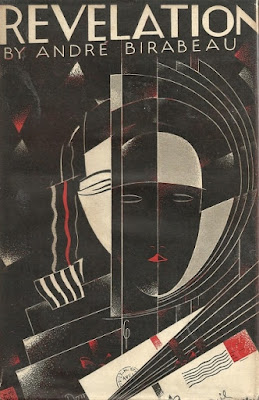 |
| New York : Viking, 1930 |
Madame Mathilde Casseneuil's husband Jean is a reporter who travels extensively and is rarely home in Paris. Mathilde's primary relationship then is with their son, Dominique. Dominique has recently taken a job with a motorcar company in Avignon and his mother has struggled with the distance now between them.
When Madame Casseneuil receives a telegram notifying her of Dominque's death in a car accident, she rushes to Avignon. She arrives at Dominique's apartment where the landlady and an unnamed gentleman recommend she not look at her son because of the damage from the car accident. The man takes her to a hotel where she can rest. The following day, while going through her son's rooms, she sees for the first time the things he surrounded himself with; a yellow silk kimono, a few pictures including a reproduction of a nude statue of Apollo, a cigarette holder. In his desk, she discovers a packet of love letters that she at first assumes are from a girl. Upon closer inspection, she realizes they are from a man and is horrified.
The remainder of the story largely takes place in Madame Casseneuil's mind as she remembers events in Dominique's life and tries to understand how her memories of him can be reconciled with what she now knows. She still thinks of her son as an innocent; not as a sexual being. Her sometimes lengthy internal dialogues are punctuated with intrusions of the present time emphasizing her sense of loss and her fumbling through the days trying to make sense of it all.
This English translation of La Debauche was performed by Lady Una Troubridge, a British sculptor and translator who is probably best known as the partner of Radclyffe Hall, author of the famous lesbian novel The Well of Loneliness (1928).
While the UK edition of Revelation (London : Victor Gollancz, 1930) was issued with a serviceable binding and the yellow paper dustjacket typical of Gollancz publications, one must draw attention to the luxe presentation by Viking Press. The deco inspired dustjacket art and corresponding binding is paired with thick cotton-heavy pages. While Revelation is a fascinating early story of a mother coming to terms with her son's homosexuality, the book itself is also a beautiful literary object.
Bibliographies & Ratings: Cory (IV); Garde (P 38**); Mattachine Review (IV); Young (284*)
Monday, April 20, 2020
Portrait of Felix Mueller by Raoul Hausmann
Sunday, April 5, 2020
Nature's Way by Herman Wouk
 |
| New York : Doubleday, 1958 |
Nature's Way is a comic play in two acts that premiered October 16, 1957 at the Coronet Theatre in New York. Newlyweds Billy and Maggie Turk are living extravagantly off of the success of Billy's first musical and they are expecting their first child. Everyone seems to want a piece of their success. When their accountant announces a miscalculation in their taxes and that they will owe an additional $50,000, they don't know how they will pay it.
Vivian Voles, Billy's creative partner, suggests he and Billy spend a few months in Venice writing the next big show. With the right investors, Billy can get the money to pay off the tax debt. Maggie isn't a fan of Vivian, nor of his plan. It's clear that Maggie believes that Vivian is trying to break the couple apart. What isn't clear is whether she believes his motive is his own romantic interest in Billy.
Set in the theater world, there is both acknowledgement and a sense that we don't talk about Vivian's sexuality. The mild comments come from Maggie and her mother, Mrs. Fawcett, who aren't from that world. The humor in the play is even handed and doesn't make a clown of Vivian's character. In fact the humor is at everyones expense.
Bibliographies & Ratings: Cory (II); Garde (OTP b*); Mattachine Review (III); Young (4235)
Tuesday, March 24, 2020
Manikins by Paul Cadmus
 |
| Manikins (1951) Paul Cadmus (American, 1904-1999) Egg tempera on paper 13 x 16 in. Private Collection |
Monday, March 9, 2020
On Swift Horses by Shannon Pufahl
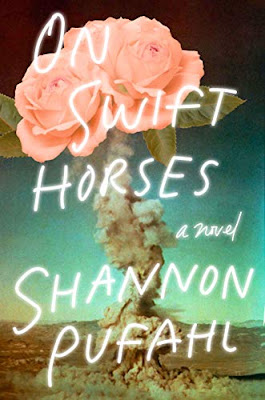 |
| New York : Riverhead Books, 2019 |
Pufahl's achingly good prose draws the reader into an intensely emotional world where the characters must make difficult decisions in order to survive; often telling lies to those they love as well as to themselves. Taking place in the newly forming suburbs of San Diego, Las Vegas and Tijuana, the characters are running both toward and away from aspects of their lives while in search of their true selves.
References to cinema of the time, especially as it relates to sex and gender presentation (ie. the western, Shane and the Marlene Dietrich film Morocco), provide a movie-like quality where the reader truly feels the story. As well, the space race, particularly the successful launch of Sputnik, and general imagery of the stars is used to speak of the future and the impossibility of keeping secrets when satellites see all that we do. The beginnings of a surveillance state are upon us.
Although underplayed by the author, the massive social changes that occurred post World War II in the United States play a crucial part in the characters lived experience. During World War II, women were needed in the workforce for the war effort and a certain amount of freedom came from that. After the war ended, expectations changed. What women were supposed to want and the roles they played were in many ways not up for discussion. Muriel's mother was able to live a life of her own making. Her daughter now finds herself with fewer perceived choices than her mother had.
The McCarthy hearings brought significant attention to gay men as a social problem. One of the characters in the book actually says that without Joseph McCarthy, most Americans wouldn't know about fairies and reds. By the time the Korean War had ended, whatever freedom gay men and lesbians felt in their invisibility, they were now receiving substantial societal pushback; and everyone, not just those in big cities, were now aware of their existence. Julius was living a life both as a gambler and a gay man where he was always in physical danger as well as danger of societal judgement should he be discovered.
Friday, February 21, 2020
Langston Hughes by Winold Reiss
Wednesday, February 5, 2020
The New Negro : The Life of Alain Locke by Jefferey C. Stewart
 |
| New York : Oxford University Press, 2018 |
2018 National Book Award
2019 Pulitzer Prize
Alain Locke was born into a Black Victorian family in Philadelphia in 1885. Stewart masterfully lays out the complexity of Locke's life through which he must balance his desire to be a successful black intellectual with his gayness.
After completing his education at Harvard where he was generally accepted, Locke has his first serious experience with racism while a Rhodes Scholar at Oxford when the scholars from the southern United States refuse to board in the same college as him and intentionally leave him out of group activities. Locke does make some friends though and escapes to mainland Europe, to Paris and Berlin, where his race is not an issue and he is free to explore his sexuality in a more open environment. His escape however proves detrimental to his scholarship and he fails to receive his degree from Oxford.
With the idea of completing his studies in Berlin, he asks his mother (with whom he maintained a close relationship) to join him there. When Archduke Ferdinand is shot, the Germans close the border and they are temporarily trapped. Although U.S. officials do work to evacuate them, due to their race, they are not a high priority. Once back in America, he takes a teaching position at Howard, but quickly realizes that without a PhD he won't achieve the standing and influence he desires. While on leave from Howard he completes his doctorate at Harvard. By this time, with the election of Woodrow Wilson—the first southern president elected since Reconstruction—race becomes more of a problem for Locke, particularly with segregated housing districts.
After completing his PhD, Locke decides to vacation in Europe and while visiting Berlin during the Weimar era, takes in some of the Modernist theater of the time. This presentation in the arts of the lives that the artists are living resonates with Locke and was a confirmation of the sort of artistic movement he envisioned for black Americans; what we would later know at the Harlem Renaissance.
Locke had been friends with several writers that are now known as part of the Harlem Renaissance; Claude McKay and Jean Toomer in particular. McKay frequently introduces Locke to new young writers, particularly young men, whom Locke encourages and mentors to a degree. The Crisis, the magazine of the NAACP, served as the primary outlet for these writers' work but simply accepted or denied work for publication instead of bringing new writers along with the sort of encouragement that Locke felt was necessary to create a movement. This was personal for Locke since he had experienced this himself with articles he submitted to the publication that didn't get him the attention from the editor that he felt he deserved.
By the time Locke returns from a trip to Europe and Egypt in 1924, Robert Kerlin has released Negro Poets and Their Poems in connection with The Opportunity, the publication of the National Urban League. This was the kind of thing that Locke had envisioned, a vehicle to promote the new writing in this movement of black writers. Charles Johnson, the editor at The Opportunity, like Locke, saw the connection between European modernism and African American poetry and theater and hoped to promote the arts within the pages of the magazine.
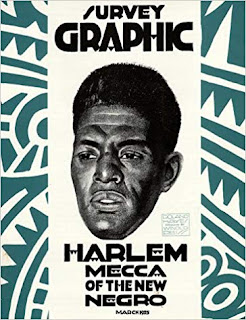 |
| 'The Harlem Number' Survey Graphic : March 1925 |
While Locke emphasized his vision for this new movement at the dinner, he emphasizes the importance of leaving old forms behind, thus alienating some the attendees. Jessie Redmon Fauset was the literary editor at The Crisis and had herself just published a novel in the style that Locke had so easily dismissed. Locke underestimated the power of Fauset and The Crisis in general however. The following day, newspaper articles describing the event omitted Johnson and Locke entirely, focusing primarily on Fauset and her new novel.
Although the dinner didn't get Locke and Johnson the sort of publicity they hoped, Paul U. Kellogg, the editor of Survey Graphic was in attendance and this led to the next opportunity for them to promote their envisioned movement. Each issue of the magazine focused deeply on a topic and Locke suggested to Kellogg the idea of an African American issue focused on the arts and featuring commentary from leading voices. Locke acted as silent editor of what would be later known as the Harlem Number. While it was a success at promoting the movement, Locke's involvement continued to be out of view.
Before the Harlem Number was published however, there were already thoughts of expanding the concept into a larger work. Albert Boni had recently started a publishing house with his brother and inquired about republishing the content of the magazine with new material in book form, also edited by Locke. This would become The New Negro: An Interpretation, published in 1925 and solidified Locke's critical role in promoting the authors and writings of what we now know as the Harlem Renaissance.
Tuesday, January 28, 2020
Jean Cocteau a l'Epoque de la Grande Roue by Romaine Brooks
 |
| Jean Cocteau à l'Époque de la Grande Roue (1912) Romaine Brooks (American, 1874-1970) Oil on canvas 251 x 135 cm Musée National d'Art Moderne on loan to Musée Franco-Américain du Château de Blérancourt |
"The painting originally included a pair of women on the balcony, standing apart from Cocteau; she cut the painting in half, making the Eiffel Tower the focus of the composition. Brooks would later delight in quoting [W. Somerset] Maugham, who predicted when the painting was first exhibited that Jean Cocteau would be remembered only because of Romaine Brooks's portrait of him."
Jamie James
Pagan Light : Dreams of Freedom and Beauty in Capri
New York : Farrar, Straus & Giroux, 2019
p.166-7
Thursday, January 16, 2020
Pagan Light : Dreams of Freedom and Beauty in Capri by Jamie James
 |
| New York : Farrar, Straus & Giroux, 2019 |
Pagan Light is a reference to maybe the most well known novel set in Capri, Norman Douglas' South Wind. Part travelogue, part literary and art history, James' book is difficult to define. It offers a series of vignettes of varying length connecting a veritable who's who of famous (and not-so-famous) literary and artistic expats. The minor players are offered as mere asides and provide a more complete sense of Capri's expat society. Pagan Light is anchored with biographical accounts of the little known novelist and poet, Jacques d'Adelswärd-Fersen and the artist Romain Brooks.
Adelswärd-Fersen flees Paris after his proclivities run afoul of the law. Interestingly it wasn't his sexual interest in teenage boys that was the problem, it was his use of them in his theatrical 'messes noires' (a supposed satanic ritual) to which he invited his friends. The details of this scandal would later be memorialized in his 1905 novel Messes Noires : Lord Lillian. An English translation of the novel, issued by Elysium Press, was published in 2005.
On Capri, Brooks was able to become an independent woman and present herself the way she was most comfortable. She cut her hair short and styled herself in trousers and jackets instead of dresses. She interacted within the society of lesbians of the time including Radclyffe Hall (author of the classic lesbian novel, The Well of Loneliness), Lady Una Troubridge (Hall's longtime lesbian partner), and American poet, Natalie Barney (Brooks' great love). Brooks is known for her portraits of important women in this lesbian circle as well as an early portrait of Jean Cocteau.
Adelswärd-Fersen and Brooks make for interesting subjects in that what we know of their lives is largely based on less than reliable depictions of them in their own and others writing. Adelswärd-Fersen's story is mostly known through The Exile of Capri, a roman à clef by Roger Peyrefitte, while Brooks' story largely comes from her own unpublished memoir as well as Compton Mackenzie's novel Extraordinary Women.
Ricardo Esposito, who runs the Capriot small press Edizioni La Conchiglia, sums up the importance of Capri nicely when he says, "Capri was an international laboratory for the avant-garde, a place where ideas were born, a new artistic vision, and given to the world." (p.288)
Friday, January 3, 2020
Ercole e Lica by Antonio Canova
Subscribe to:
Posts (Atom)


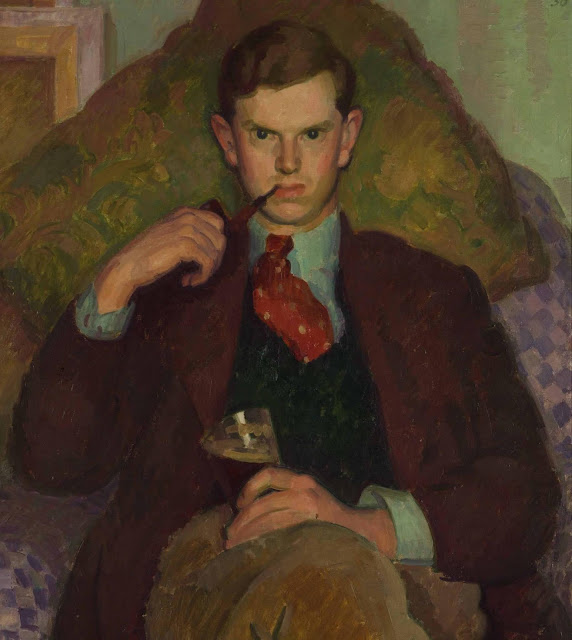

![The World Next Door by Fritz Peters ; FROM LEFT TO RIGHT: [1] New York : Harper's Bazaar, July 1949 (excerpt) [2] London : Victor Gollancz, 1950 [3] New York : Signet/NAL, 1950 [4] Le Monde à Côté, French translation by Amélie Audiberti, Paris : Éditions Denoël, 1953 [5] Die Welt Nebenan, German translation by Utta Seifert-Roy, Hamburg : P. Zsolnay, 1956 [6] London : Victor Gollancz, 1967 The World Next Door by Fritz Peters ; FROM LEFT TO RIGHT: [1] New York : Harper's Bazaar, July 1949 (excerpt) [2] London : Victor Gollancz, 1950 [3] New York : Signet/NAL, 1950 [4] Le Monde à Côté, French translation by Amélie Audiberti, Paris : Éditions Denoël, 1953 [5] Die Welt Nebenan, German translation by Utta Seifert-Roy, Hamburg : P. Zsolnay, 1956 [6] London : Victor Gollancz, 1967](https://blogger.googleusercontent.com/img/b/R29vZ2xl/AVvXsEgHC8GJDTCnn2q_JPEuR13aaQzCS64gXcJTNbNZEQI60GMvu8TrE1EPI29xwiMrao8RL9xd0txHVOnBbgTgrh7djjj6C8_Hic_X4NuVbi_QkOfAsRA_8XYjs0mLtxgf3yFY9xRJxhvrMAo/s640/Peters_WorldNextDoor_combo.jpeg)






